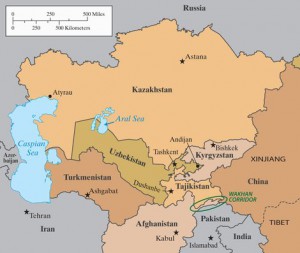EXTRACT:
China and Central Asia
None of the works under review provides the full answers to these questions, although Alexander Cooley’s book, Great Games, Local Rules, comes closest. They all agree on the unprecedented rise of China’s influence in Central Asia. Marlène Laruelle and Sébastien Peyrouse, scholars at George Washington University in Washington, D.C., demonstrate in The Chinese Question in Central Asia that China is already the dominant economic power in the region.

China has also taken care of one vital strategic interest since 1991: making sure that the Uighurs, China’s largest Muslim ethnic group who live in the western province of Xinjiang, do not seriously threaten to become independent and that the hundreds of thousands of Uighurs who live in Central Asia do not help them do so. During the 1950s large numbers of Uighurs fled the Maoist regime to seek shelter in Soviet Central Asia where they were relatively well treated.
After 1991 China put immense pressure on the three Central Asian states that border Xinjiang—Kazakhstan, Tajikistan, and Kyrgyzstan—to tightly restrict all Uighur political activity on their soil. China offered sweeteners such as resolving the border disputes that had plagued Chinese–Soviet relations in Central Asia for decades. Within a decade the borders between China and the Central Asian states were demarcated and settled, allowing for China’s rapid economic involvement in the region.
Still, Uighur nationalism and Islamic militancy have continued to mount in Xinjiang, as China has inundated the province with Han Chinese and severely repressed the Muslims. While the Uighur populations in Central Asia have been largely silenced, some Uighurs have been training and fighting with the Taliban in Pakistan and Afghanistan.
During the past decade China has invested heavily in Central Asia. Laruelle and Peyrouse write that
in less than ten years, China has positioned itself as one of the top three trading partners for each of the Central Asian states. It controls a quarter of Kazakh oil and has built a pipeline going from the Caspian Sea to Xinjiang; has become the preferred client of Turkmenistan for its gas exports; has transformed Kyrgyzstan into an economic quasi-protectorate that survives mainly on the re-export of Chinese products, and Tajikistan into a privileged gateway to its presence in Afghanistan.
The findings of the two authors seem to me vital for any serious discussion of China’s future geopolitical role in Asia. Their trade figures show the remarkable pace of Chinese investment. In 2002 China’s trade with Central Asia was no more than $1 billion. In 2006 it reached $10 billion and by 2010, $28 billion. In contrast, Russia’s trade with Central Asia in 2010 was just $15 billion. China has broken the economic connections that traditionally tied Central Asia to Russia.
China also broke Russia’s monopoly of Kazkah oil and Turkmen natural gas. Now two Chinese-built pipelines, one originating in Atyrau on the Kazakh shores of the Caspian Sea and the other in Turkmenistan, carry respectively oil and gas across the length of Central Asia to Xinjiang from which new pipelines are being built to China’s industrial heartland on the coast. The gas pipeline will soon have spurs that will mop up further gas output in Uzbekistan, Kazakhstan, and eventually Afghanistan. Cooley described in an interview “a growing sucking sound coming from the East.” These Central Asian energy supplies provide China with enormous security, since they much reduce Chinese dependence on seaborne imports of energy, which the US could try to limit.
However, China also faces much hostility in Central Asia, as it does elsewhere in the third world, for the ways it exploits the region while offering little in return. Chinese companies bring their own workers and equipment, refusing to hire locally, carry out local job training, or buy large quantities of local goods and produce. It is common to hear conspiracy theories about China buying up agricultural land in Central Asia or settling millions of its peasant farmers there. Central Asian people fear Chinese influence even as their leaders embrace China, which does not question them about their lack of democracy or human rights, or their reluctance to introduce economic reform. The West is considered too intrusive.
According to “China’s Central Asia Problem,” a recent report by the International Crisis Group:
China’s business practices are providing a negative image in a region where suspicions of China…are already high…. China sees a certain affinity between Central Asia’s authoritarian regimes and its own, and in public, at least, defends them with similar rhetoric.
The report suggests that China’s current trade and investment practices in Central Asia cannot last forever without more visible concern to improve the lives of the local population. Yet China appears to be repeating the same policies in Afghanistan, with which it shares a fifty-mile border in the Wakhan corridor. During the past decade it has refused to give serious help to the Afghans, whether in providing security or developing infrastructure. Over the last twelve years it has provided barely $2 billion in economic aid to Afghanistan—less than what a much poorer India has provided with many more enlightened projects.



